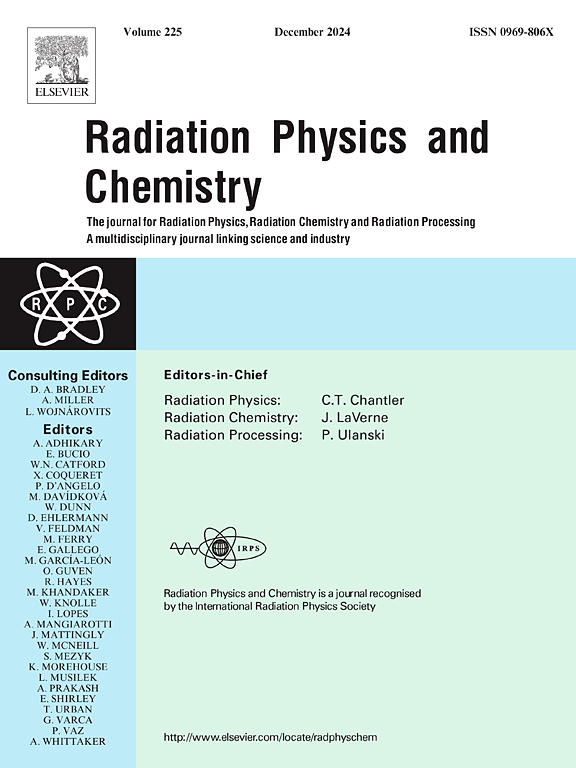Theoretical investigation of dosimeter accuracy for linear energy transfer measurements in proton therapy: A comparative study of stopping power ratios
IF 2.8
3区 物理与天体物理
Q3 CHEMISTRY, PHYSICAL
引用次数: 0
Abstract
Background
Accurate measurement of linear energy transfer (LET) is crucial in medical physics, particularly for proton therapy dosimetry. High atomic-number () materials such as BaFBr and low- materials such as and water are commonly used in dosimeters.
Purpose
To evaluate the feasibility and accuracy of the use of various dosimetry materials (water, air, , aluminum (Al), BaFBr, and oxygen) for measuring LET by comparing their stopping power (ratios) via the Bethe-Bloch theory and semiempirical models.
Methods
Stopping power ratios were calculated via the PSTAR database for proton energies ranging from 0.01 MeV to 10,000 MeV. The Bethe-Bloch theory with density and shell corrections was used for high-energy protons, whereas a semiempirical model was applied for low-energy protons. Calculations validation involved comparing the computed stopping powers SRIM-2008 and PSTAR for materials such as water, aluminum, air, , BaFBr, and oxygen.
Results
The stopping power water-to-air ratio remains stable, while the -to-water and air-to-water ratios highlight their differing attenuation properties. The BaFBr-to-water ratio shows significant material-dependent differences, and the water-to- ratio is particularly relevant for proton therapy dosimetry calculations in medical physics. These results demonstrate consistency across materials but do not inherently confirm the accuracy of LET measurements. However, a comparison of theoretical models with computed stopping powers SRIM-2008 and PSTAR showed strong agreement, particularly for high-energy protons where the Bethe-Bloch theory was applied, suggesting that the models reliably predict stopping power at these energy levels.
Conclusions
This study confirms the feasibility of using high- materials such as BaFBr and low- materials such as and water for the use of LET measurements in proton therapy. The results validate the use of the Bethe-Bloch theory, computed stopping powers and semiempirical models in dosimetric applications, enhancing the precision of LET measurements and contributing to improved radiation therapy outcomes.
质子治疗中线性能量转移测量剂量计精度的理论研究:停止功率比比较研究
背景精确测量线性能量传递(LET)对医学物理学,尤其是质子治疗剂量测定至关重要。高原子序数(Zeff)材料(如 BaFBr)和低 Zeff 材料(如 Al2O3 和水)常用于剂量计中。目的通过比较各种剂量测定材料(水、空气、Al2O3、铝 (Al)、BaFBr 和氧气)在 Bethe-Bloch 理论和半经验模型下的停止功率(比率),评估使用这些材料测量 LET 的可行性和准确性。方法通过 PSTAR 数据库计算质子能量从 0.01 MeV 到 10,000 MeV 的停止功率比率。对高能质子采用了带密度和壳修正的贝特-布洛赫理论,而对低能质子则采用了半经验模型。计算验证包括比较水、铝、空气、Al2O3、BaFBr 和氧气等材料的计算停止功率 SRIM-2008 和 PSTAR。BaFBr 与水的比率显示出显著的材料差异,而水与 Al2O3 的比率与医学物理学中的质子治疗剂量测定计算尤为相关。这些结果表明了不同材料之间的一致性,但并不能从本质上确认 LET 测量的准确性。然而,理论模型与计算的停止功率 SRIM-2008 和 PSTAR 的比较显示出很强的一致性,特别是对于应用了 Bethe-Bloch 理论的高能质子,这表明模型能可靠地预测这些能级的停止功率。研究结果验证了在剂量测定应用中使用 Bethe-Bloch 理论、计算的停止功率和半经验模型的有效性,提高了 LET 测量的精确度,有助于改善放射治疗效果。
本文章由计算机程序翻译,如有差异,请以英文原文为准。
求助全文
约1分钟内获得全文
求助全文
来源期刊

Radiation Physics and Chemistry
化学-核科学技术
CiteScore
5.60
自引率
17.20%
发文量
574
审稿时长
12 weeks
期刊介绍:
Radiation Physics and Chemistry is a multidisciplinary journal that provides a medium for publication of substantial and original papers, reviews, and short communications which focus on research and developments involving ionizing radiation in radiation physics, radiation chemistry and radiation processing.
The journal aims to publish papers with significance to an international audience, containing substantial novelty and scientific impact. The Editors reserve the rights to reject, with or without external review, papers that do not meet these criteria. This could include papers that are very similar to previous publications, only with changed target substrates, employed materials, analyzed sites and experimental methods, report results without presenting new insights and/or hypothesis testing, or do not focus on the radiation effects.
 求助内容:
求助内容: 应助结果提醒方式:
应助结果提醒方式:


